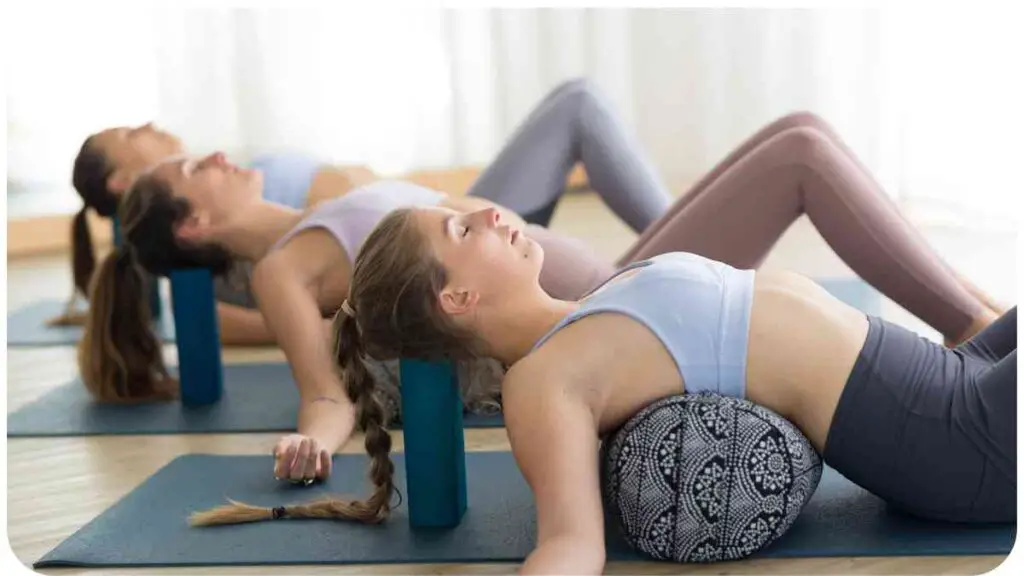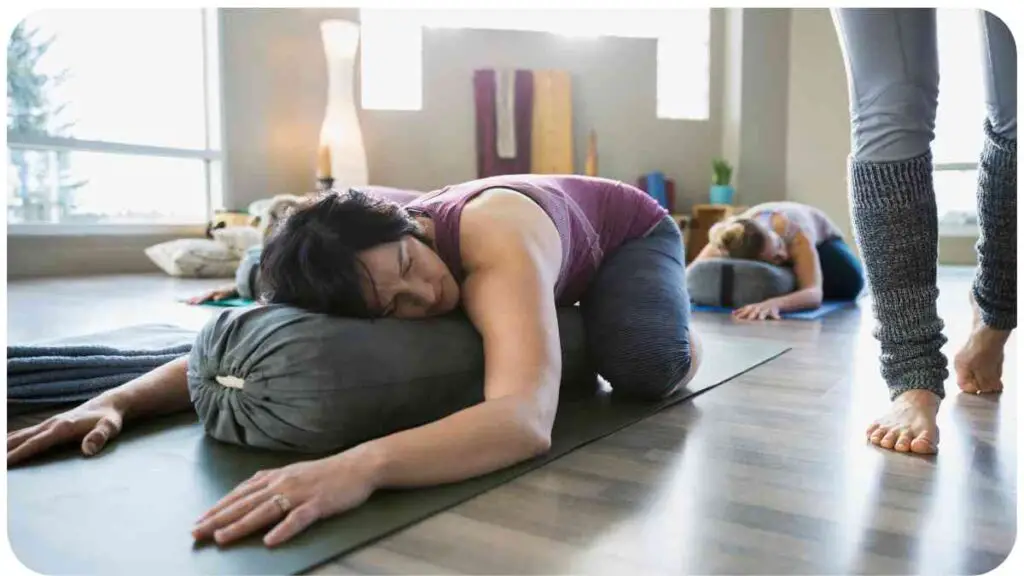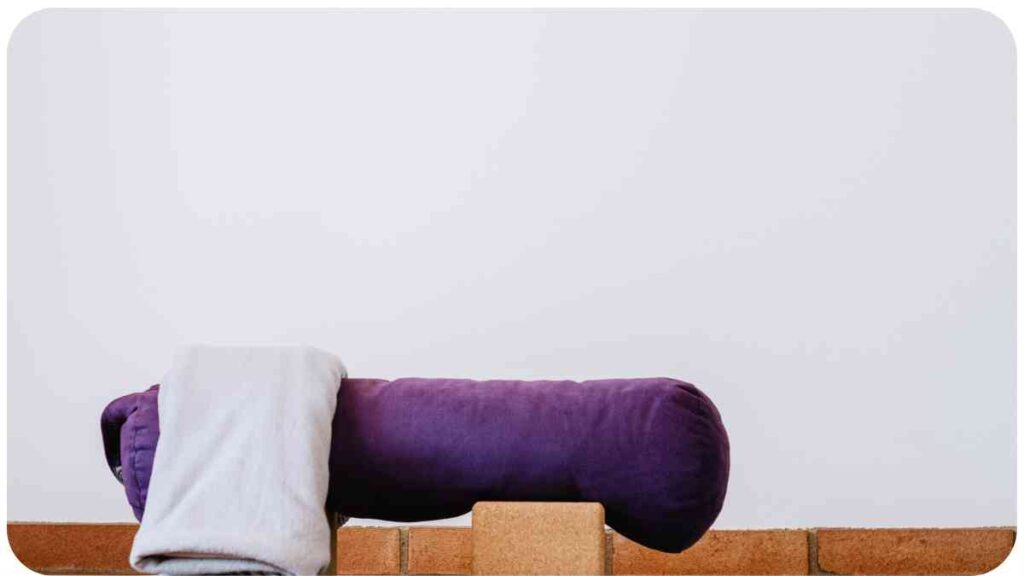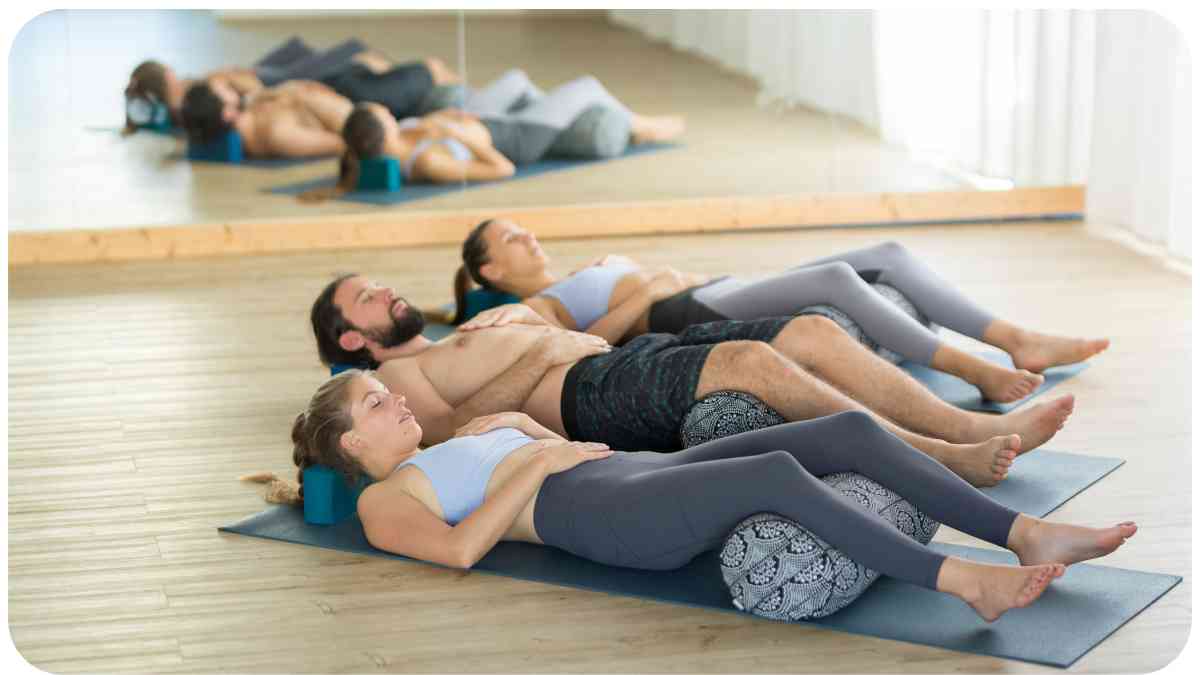Yoga bolsters are versatile props that offer support and comfort during yoga practice. These cylindrical cushions are commonly used to deepen stretches, promote relaxation, and improve alignment. Whether you’re a beginner or an experienced yogi, incorporating a yoga bolster into your practice can enhance your overall experience on the mat.
| Takeaways |
|---|
| Yoga bolsters offer support and comfort |
| They enhance relaxation and alignment |
| Different types cater to various needs |
| Proper maintenance ensures longevity |
| Incorporate bolsters creatively in practice |
Table 1: Benefits of Using a Yoga Bolster
| Benefits | Description |
|---|---|
| Enhances Relaxation | Provides support for longer holds in restorative poses, allowing the body to release tension and promoting deep relaxation. |
| Improves Alignment | Helps to align the body properly in poses, reducing the risk of strain or injury and allowing for a more effective stretch. |
| Deepens Stretches | Allows for a deeper opening in muscles and joints, facilitating a more profound stretch and increasing flexibility over time. |
| Supports Restorative Yoga Practice | Ideal for restorative yoga, where passive poses are held for extended periods to promote relaxation and healing. |
2. Benefits of Using a Yoga Bolster

Yoga bolsters offer a multitude of benefits, making them a valuable addition to any yoga practice. Let’s delve deeper into some of the advantages they provide:
Pranayama, or breath control, is fundamental in yoga. Learn how to harness its power and enhance your practice with Understanding Pranayama techniques.
Table 2: Types of Yoga Bolsters
| Type | Description |
|---|---|
| Round Bolster | Cylindrical in shape, provides even support throughout the body, ideal for various restorative and yin poses. |
| Rectangular Bolster | Rectangular shape with flat surface, offers stable support for a wide range of poses, including backbends. |
| Pranayama Bolster | Smaller and thinner than standard bolsters, designed specifically for supporting the spine during pranayama. |
| Half Moon Bolster | Semi-circular shape, perfect for providing gentle support in poses that require elevation or gentle backbends. |
When selecting a bolster, consider your body type, flexibility, and the type of yoga you practice. Round bolsters are versatile and great for most practitioners, while rectangular bolsters provide firmer support. Pranayama bolsters are designed for breathing exercises, and half-moon bolsters offer additional support for gentle backbends.
Table 3: Choosing the Right Yoga Bolster for You
| Considerations | Description |
|---|---|
| Size | Ensure the size of the bolster fits your body and supports you comfortably in various poses. |
| Firmness | Decide on the firmness based on personal preference and the level of support required for your practice. |
| Material | Look for bolsters made from durable and easy-to-clean materials such as cotton, hemp, or microfiber. Avoid synthetic materials that may cause irritation. |
| Budget | Set a budget and explore options within that range, considering the quality and longevity of the bolster. |
By considering these factors, you can choose a bolster that aligns with your needs and enhances your yoga practice. Whether you’re seeking relaxation, improved alignment, or deeper stretches, the right bolster can make a significant difference in your experience on the mat.
Explore the versatility of yoga blocks and elevate your practice. Discover step-by-step guidance on their usage in our comprehensive guide, How to Use Yoga Blocks.
3. How to Use a Yoga Bolster
Using a yoga bolster effectively can enhance your practice by providing support and comfort in various poses. Let’s explore some common ways to incorporate a bolster into your yoga routine:
Supported Child’s Pose
Description: Begin by kneeling on the mat with your big toes touching and knees wide apart. Place the bolster between your thighs, then lower your torso onto the bolster, extending your arms forward or resting them alongside your body. Relax your forehead on the bolster and breathe deeply, allowing your spine to lengthen and your hips to release.
Table 4: Supported Child’s Pose
| Steps | Instructions |
|---|---|
| 1. Begin kneeling on the mat. | Ensure your knees are wide apart and your toes are touching behind you. |
| 2. Place the bolster between your thighs. | Position the bolster vertically, aligning it with your torso. |
| 3. Lower your torso onto the bolster. | Extend your arms forward or rest them alongside your body, palms facing down. |
| 4. Relax your forehead on the bolster. | Allow your forehead to rest on the bolster, relaxing your neck and releasing tension. |
| 5. Breathe deeply and hold the pose. | Take slow, deep breaths, feeling the support of the bolster as you relax into the pose. |
Supported Child’s Pose is excellent for releasing tension in the back, hips, and shoulders, making it an ideal posture for relaxation and introspection.
Reclining Bound Angle Pose
Description: Lie on your back with knees bent and feet flat on the floor. Place the bolster lengthwise behind your back, supporting your spine. Bring the soles of your feet together and allow your knees to fall open to the sides. Relax your arms by your sides or extend them overhead. Close your eyes and breathe deeply, feeling the gentle opening in your hips and chest.
Table 5: Reclining Bound Angle Pose
| Steps | Instructions |
|---|---|
| 1. Lie on your back. | Extend your legs out in front of you, then bend your knees and bring your feet towards your hips. |
| 2. Place the bolster behind your back. | Position the bolster lengthwise along your spine, ensuring it supports your entire torso. |
| 3. Bring the soles of your feet together. | Allow your knees to fall open to the sides, creating a diamond shape with your legs. |
| 4. Relax your arms by your sides. | Keep your arms relaxed alongside your body, palms facing up, or extend them overhead. |
| 5. Breathe deeply and relax into the pose. | Close your eyes and take slow, deep breaths, allowing your body to soften and release tension. |
Reclining Bound Angle Pose is a restorative posture that opens the hips and chest while promoting relaxation and stress relief.
Delve into the philosophical roots of yoga beyond the mat. Understand the holistic approach of yoga through the lens of Understanding the 8 Limbs of Yoga principles.
Supported Bridge Pose
Description: Lie on your back with knees bent and feet hip-width apart. Place the bolster horizontally under your sacrum, supporting your lower back. Press into your feet and lift your hips towards the ceiling, creating a gentle backbend. Keep your arms relaxed by your sides or interlace your fingers underneath you. Hold the pose, breathing deeply into the chest and belly.
Table 6: Supported Bridge Pose
| Steps | Instructions |
|---|---|
| 1. Lie on your back. | Bend your knees and place your feet hip-width apart, ensuring your spine is in a neutral position. |
| 2. Place the bolster under your sacrum. | Slide the bolster horizontally under your sacrum, adjusting it for comfort and support. |
| 3. Press into your feet and lift your hips. | Engage your glutes and thighs as you lift your hips towards the ceiling, creating a gentle backbend. |
| 4. Relax your arms by your sides. | Keep your arms relaxed alongside your body, palms facing down, or interlace your fingers underneath. |
| 5. Hold the pose and breathe deeply. | Stay in the pose for several breaths, feeling the gentle opening in your chest and hip flexors. |
Supported Bridge Pose stretches the chest, shoulders, and spine while strengthening the legs and glutes, making it an excellent pose for improving posture and relieving back pain.
Savasana
Description: Lie on your back with legs extended and arms by your sides, palms facing up. Place the bolster under your knees to support the lower back and release tension in the legs. Close your eyes and relax your entire body, surrendering to the present moment and allowing yourself to fully let go.
Table 7: Savasana with Bolster
| Steps | Instructions |
|---|---|
| 1. Lie on your back. | Extend your legs out in front of you, allowing your feet to fall open naturally. |
| 2. Place the bolster under your knees. | Slide the bolster under your knees, ensuring it supports your lower back and relaxes the legs. |
| 3. Relax your arms by your sides. | Keep your arms relaxed alongside your body, palms facing up, fingers gently curled. |
| 4. Close your eyes and breathe deeply. | Release any tension in your body and mind, allowing yourself to fully surrender to the present moment. |
Savasana with a bolster provides optimal support for relaxation, allowing you to fully unwind and experience deep rest and rejuvenation.
By incorporating these bolster-supported poses into your yoga practice, you can enhance your flexibility, promote relaxation, and cultivate a deeper connection with your body and breath. Experiment with different poses and bolster placements to discover what works best for you, and enjoy the supportive benefits of this versatile yoga prop.
4. Tips for Proper Use

To make the most of your yoga bolster and ensure a safe and effective practice, consider these helpful tips:
Encounter common hurdles in your yoga journey and how to overcome them. Find solutions to refine your practice in our guide, Troubleshooting Your Yoga Practice.
Table 8: Tips for Proper Use of Yoga Bolsters
| Tips | Description |
|---|---|
| Listen to Your Body | Pay attention to how your body feels in each pose and adjust the bolster as needed to support your comfort and alignment. |
| Start Slowly | If you’re new to using a bolster, start with gentle poses and gradually increase the duration and intensity as you become more comfortable. |
| Experiment with Placement | Explore different ways to position the bolster in each pose to find the most supportive and comfortable arrangement for your body. |
| Use Props as Needed | Don’t hesitate to use additional props such as blocks or blankets in conjunction with your bolster to enhance support and alignment. |
| Focus on Breathing | Incorporate deep, mindful breathing into your practice to enhance relaxation and promote a greater sense of calm and presence. |
By following these tips, you can optimize your use of a yoga bolster and experience the full benefits of this versatile prop in your practice.
5. Incorporating a Yoga Bolster into Your Practice
Once you’re familiar with using a yoga bolster, you can incorporate it into a variety of poses to enhance your practice. Here are some creative ways to integrate a bolster into your yoga routine:
Table 9: Poses for Incorporating a Yoga Bolster
| Pose | Description |
|---|---|
| Supported Twist | Place the bolster under your bent knee in a seated or supine twist to deepen the stretch and promote spinal rotation. |
| Shoulder Opener | Lie on your back with the bolster lengthwise under your spine, opening your arms out to the sides to stretch the chest and shoulders. |
| Legs-Up-the-Wall Pose | Sit close to a wall and place the bolster under your hips, then extend your legs up the wall for a gentle inversion that promotes circulation and relaxation. |
| Heart Opening | Lie back with the bolster supporting your upper back, allowing your heart to open and shoulders to release tension. |
Experiment with these poses and explore new ways to incorporate your bolster into your practice to discover what feels best for your body.
6. Common Mistakes to Avoid
While using a yoga bolster can enhance your practice, it’s essential to be mindful of potential pitfalls. Here are some common mistakes to avoid:
Table 10: Common Mistakes When Using a Yoga Bolster
| Mistakes | Description |
|---|---|
| Overusing the Bolster | Avoid relying too heavily on the bolster in every pose, as this can prevent you from developing strength and stability on your own. |
| Ignoring Alignment | Pay attention to proper alignment in each pose and use the bolster to support alignment rather than compensate for poor form. |
| Forcing Yourself into Poses | Listen to your body and respect its limits, avoiding the temptation to push yourself too far into poses with the bolster. |
| Neglecting Your Breath | Remember to breathe deeply and mindfully in each pose, using the breath to guide your movements and promote relaxation. |
By being aware of these common mistakes, you can use your yoga bolster mindfully and effectively to support your practice and enhance your overall experience on the mat.
7. Maintaining and Cleaning Your Yoga Bolster

Proper maintenance and cleaning are essential for prolonging the life of your yoga bolster and ensuring hygienic use. Here are some tips for caring for your bolster:
Experience the tremors of your body in yoga and decipher their meaning. Explore the causes and remedies for body shakes with insights from Why Does Your Body Shake in Yoga exploration.
Table 11: Maintenance and Cleaning Tips for Yoga Bolsters
| Tips | Description |
|---|---|
| Spot Clean Regularly | Wipe down your bolster with a damp cloth after each use to remove sweat, dirt, and oils and prevent buildup. |
| Deep Clean Periodically | Depending on use, machine wash your bolster on a gentle cycle with mild detergent and air dry thoroughly. |
| Store Properly | Store your bolster in a cool, dry place away from direct sunlight to prevent fading and damage to the fabric. |
By following these maintenance and cleaning tips, you can keep your yoga bolster clean, fresh, and in optimal condition for many years of use.
8. Conclusion
In conclusion, a yoga bolster is a versatile prop that can enhance your yoga practice by providing support, comfort, and stability in various poses. By choosing the right bolster for your needs, using it mindfully and effectively, and incorporating it into your practice creatively, you can reap the many benefits this prop has to offer.
Remember to listen to your body, focus on proper alignment, and breathe deeply as you explore new ways to use your bolster on the mat. With regular maintenance and care, your yoga bolster can be a valuable companion on your yoga journey, supporting you in your pursuit of health, wellness, and inner peace.
Further Reading
Here are some additional resources for further exploring the use of yoga bolsters:
- How to Choose the Right Yoga Bolster: This comprehensive guide offers tips and advice for selecting the perfect yoga bolster to suit your practice needs.
- 20 Exercises in Pictures: How to Use a Yoga Bolster: Explore a variety of yoga bolster exercises with step-by-step visual instructions to deepen your practice.
- How to Use a Yoga Bolster: Discover practical tips and techniques for incorporating a yoga bolster into your practice to enhance relaxation, flexibility, and alignment.
FAQs
Have questions about yoga bolsters? Here are some commonly asked questions and their answers:
How do I choose the right size yoga bolster for me?
Answer: The size of your yoga bolster should correspond to your body size and the type of poses you practice. Generally, larger individuals may prefer larger bolsters for added support, while smaller individuals may find smaller bolsters more comfortable.
Can I use a yoga bolster if I’m a beginner?
Answer: Absolutely! Yoga bolsters are suitable for practitioners of all levels, including beginners. They provide support and stability, making poses more accessible and enjoyable, especially for those who may be less flexible or have limited mobility.
How do I clean and maintain my yoga bolster?
Answer: Spot clean your yoga bolster regularly with a damp cloth to remove sweat, dirt, and oils. For a deeper clean, machine wash it on a gentle cycle with mild detergent and air dry thoroughly. Store your bolster in a cool, dry place away from direct sunlight to prevent fading and damage to the fabric.
Can I use a yoga bolster for meditation?
Answer: Yes, you can use a yoga bolster for meditation by placing it under your hips or knees to provide support and promote comfort during seated or lying meditation practices. The bolster helps maintain proper alignment and reduces strain on the back and hips, allowing for a more comfortable and focused meditation experience.
How can I incorporate a yoga bolster into my home practice?
Answer: There are countless ways to incorporate a yoga bolster into your home practice. You can use it to support restorative poses, deepen stretches, or enhance relaxation. Experiment with different poses and bolster placements to find what feels best for your body and intentions on any given day.

Hello, my name is Hellen James! I am a yoga teacher and writer who loves to share information about how you can achieve a more fulfilling life. I have been practicing mindfulness, yoga, and meditation for over 10 years. My passion for these practices has led me to teach them to others.

